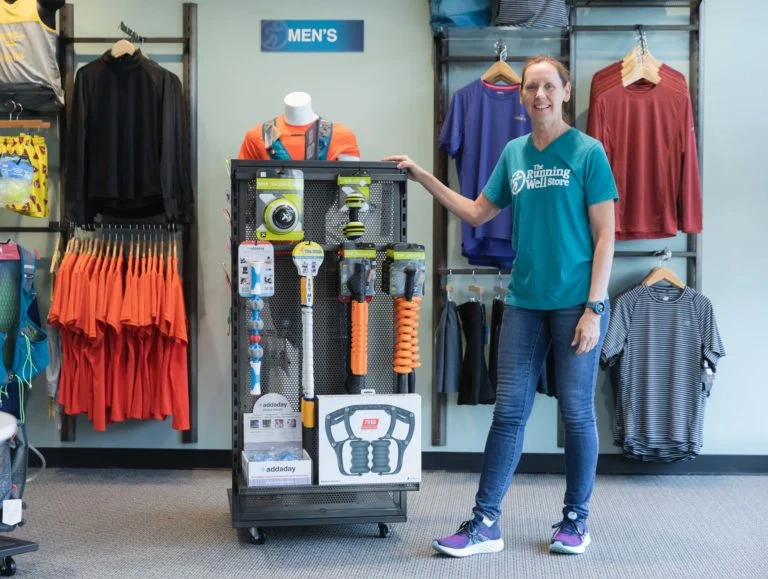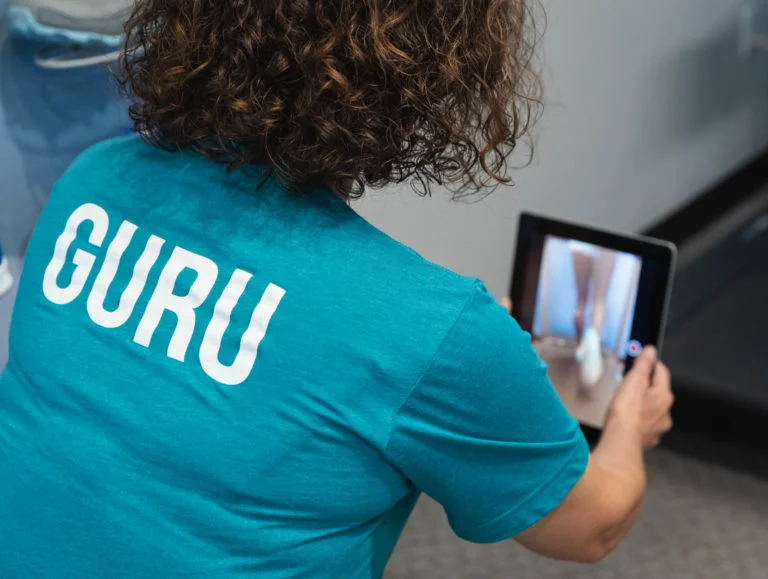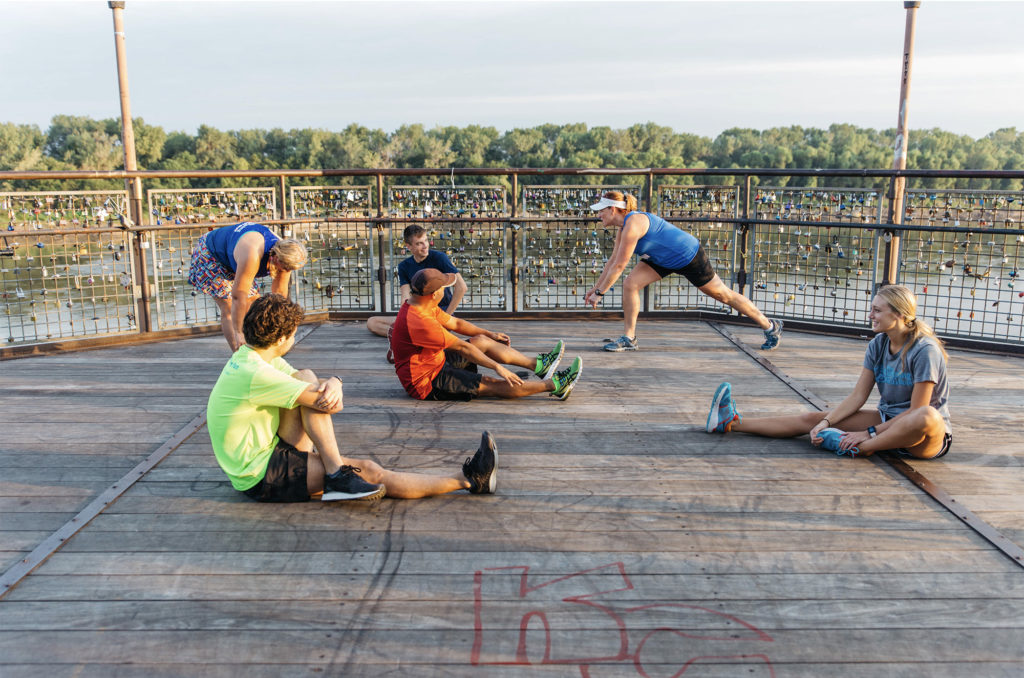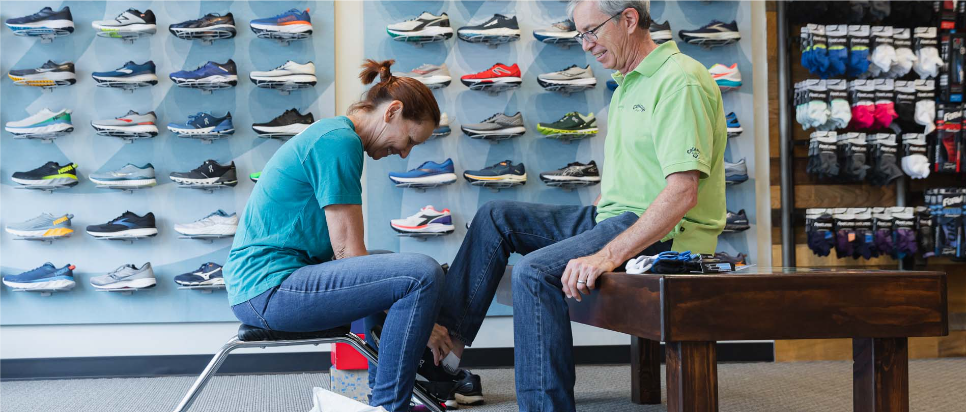Injuries are nothing to take lightly.
Unable to walk because your Achilles tendon feels like a stiff rubber band? You could be suffering from Achilles Tendinitis.
This is a common issue that runners, walkers, and everyday individuals on their feet all day deal with. The Running Well Store prides itself on making sure you are listened to and that you get the information you need. Our team goes above and beyond to help you find the best shoes (and other helpful products) for your Achilles Tendinitis pain.


About Achilles Tendinitis
Achilles Tendinitis is painful and affects many athletes from those in pro-football (like former Kansas City Chiefs player Eric Berry) to TRWS GURUs (Bruce!) to recreational walkers. With the proper tools and education, you can prevent it, treat it, and get back on your feet!
The Achilles tendon is a band of tissue that connects the calf muscles at the back of your lower leg to your heel bone. In the runners’ world, Achilles Tendinitis most often occurs when a runner increases the duration of their runs or has increased the intensity. Most people will notice stiffness or tenderness, especially in the morning, in the back of the leg or above the heel when dealing with Achilles Tendinitis.
Simply, Achilles Tendinitis means the tendon has become inflamed. Inflammation is how the body reacts to a situation when an area has become injured or diseased. Inflammation is the culprit behind causes such as swelling, pain, and irritation. Based on which part on the tendon is inflamed, there are two different types of Achilles Tendinitis.


Noninsertional Achilles Tendinitis is when the middle of the tendon has begun to breakdown with tiny tears, thicken, and swell. We see Noninsertional Achilles Tendinitis more often in younger individuals and typically more active people.
Insertional Achilles Tendinitis is the lower part of the heel where the tendon attaches. Individuals with Insertional Achilles Tendinitis typically report tenderness directly in the area. This is because of the tendon fibers calcifying (hardening). Also common are the development of bone spurs (extra bone growth) in a certain area of the heel. Insertional Achilles Tendinitis can affect people at any point, but we mainly see it after years of overuse (distance runners, sprinters).
There is not a specific injury that is typically associated with Achilles Tendinitis, rather placing stress on the tendon is the key problem. This could occur by overusing the capacity of our bodies, having tight calf muscles, and beginning exercise aggressively, or dealing with bone spurs (extra bone growth where the Achilles tendon attaches to the heal).
Forrest Gump gave the unreal expectations of being able to run across the whole United States with no training, but we do not recommend embarking on a 2,680-mile run. This will absolutely result in Achilles Tendonitis, and most likely a trip to the emergency room.
While working out, if you hear a pop in the back of your calf or heel, stop what you are doing immediately. We see so many people try to “work through it” and make it worse. Don’t hesitate to talk to your doctor!
Symptoms of Achilles Tendinitis:
Common symptoms of Achilles Tendinitis include pain and stiffness along the Achilles tendon in the morning. If you notice pain throughout the day, or while exercising, these could be indicators as well.
Common symptoms include:
- Pain and stiffness along the Achilles tendon in the morning
- Pain along the tendon or back of the heel that worsens with activity, severe pain the day after exercising
- Thickening of the tendon, bone spur (insertional tendinitis)
- Swelling that is present all the time and gets worse throughout the day with activity

Tips For How To Treat Achilles Tendinitis
Here are some tips and tricks when dealing with Achilles Tendinitis
Gradual Progression
Being mindful of gradual progression when increasing your time and intensity of runs is important. Err on the side of caution and avoid routes that are hilly or that would place excess tension on your Achilles.
Rest
Review films of the iconic character Homer Simpson to study the professional way to be lazy. Stopping the activities that are causing pain is the first way to let the area heal. If you are typically doing high-impact activities, instead switch to things that are low impact. This will cause less stress upon the Achilles Tendon. (Examples of low-impact activities include yoga, swimming, elliptical, etc. )
Ice
This should become a daily practice that does not exceed 20 minutes and stops before the area feels numb. Take something cold, like an icepack, and place it upon the back of your heel. Another great reusable icepack idea is to fill a foam cup with water and then let it freeze.
Non-Steroidal Anti-Inflammatory Medication
There are over-the-counter drugs such as Ibuprofen and Naproxen that reduce pain and swelling. The medicine will not help with the Achilles thickness but should help with the pain. Do not become reliant on over-the-counter medicine in the same way the Chiefs rely on Patrick Mahomes to get a first down on a 3rd and 14.
Stretching
Everything in the body is linked. Tightness in one part of your body can be solved by stretching another part! Having issues with one area can most likely be solved by stretching out another area. We know that your Achilles tendon can sometimes feel like a dry pasta noodle, but it is essential for that area to be tended to. For Achilles Tendonitis, stretch your calf. Lean forward against a wall with one knee straight and one knee bent. Push your hips toward the wall and hold for 10 seconds and then relax. Repeat this exercise 10 times for each foot. In order to make sure you are doing the stretch correctly; you should feel a slight pull on the calf muscle. Please be careful and not overdue this stretch.
Foam Roller
Foam rolling the calf muscle is very important while you recover from Achilles Tendinitis. The foam roller helps loosen the calf muscle and reduce some tension on the Achilles. We recommend foam rolling several times a day while you are overcoming this injury.
Supportive Shoes and Orthotics
The Running Well Store is committed to making sure that you receive the best pair of shoes for your situation. When dealing with Achilles Tendinitis, our GURUs typically recommend a higher offset shoe or a very cushioned shoe. The offset of a shoe refers to the difference in the amount of material from the heel to the forefoot. In higher offset shoes, pressure on the Achilles tendon is lessened, and that pressure is moved upward due to the back heel being higher. We recommend if you are dealing with this issue to get a stride analysis at TRWS and try on several pairs of shoes. Schedule a fitting and come see us virtually or in person!
Advice from Dr. Pete Casey
Poor ankle mobility, over-stabilized footwear (like wearing stability shoes plus an insert), decreasing the heel-drop on your running shoe too rapidly, and a “bouncy” running technique are hidden but preventable ways to overload the Achilles tendon and develop tendinitis. Stretching and foam rolling the calves is a good place to start if you are developing a sore Achilles tendon.
Dr. Pete Casey, Rehab Chiropractor
NXT Rehab & Wellness
https://NXTKC.COM

Not sure where to start?
The road to recovery is best run cautiously and patiently.
If you live in the Kansas City area, have Achilles Tendinitis, and are seeking premium products to help find relief from your pain, The Running Well Store can help. Schedule a fitting online or simply give your nearest location a call and we’ll provide personalized recommendations to get you back to your fitness goals.
Frequently Asked Questions
How long does it take to get rid of Achilles Tendinitis?
This is completely is determined by the severity of the case. It can take up to 2-3 months for the pain to go away, but with application of ice, stretching, and wearing the correct shoes make a world of difference.
How often should I be stretching and using ice?
Make sure that this becomes a daily routine. For the tendon to begin to heal, stretching and ice are your greatest friends. This will also be essential in the prevention of Achilles Tendonitis.
I tried "blank" shoe, but it did not work. Can I bring it back?
Yes! You have a full 30 days to bring the shoe back for 100% store credit if purchased at full price. You can exchange your shoe with something that is personalized to your issue. Just make sure you either have your receipt or have created an account with us so we can look up your purchase history.
Do you recommend any physical therapy places?
Yes! KC Spine and Joint is on N. Congress Ave, right next to Park Hill High School. Their team of expert individuals could further assist you with any extra attention you need.
